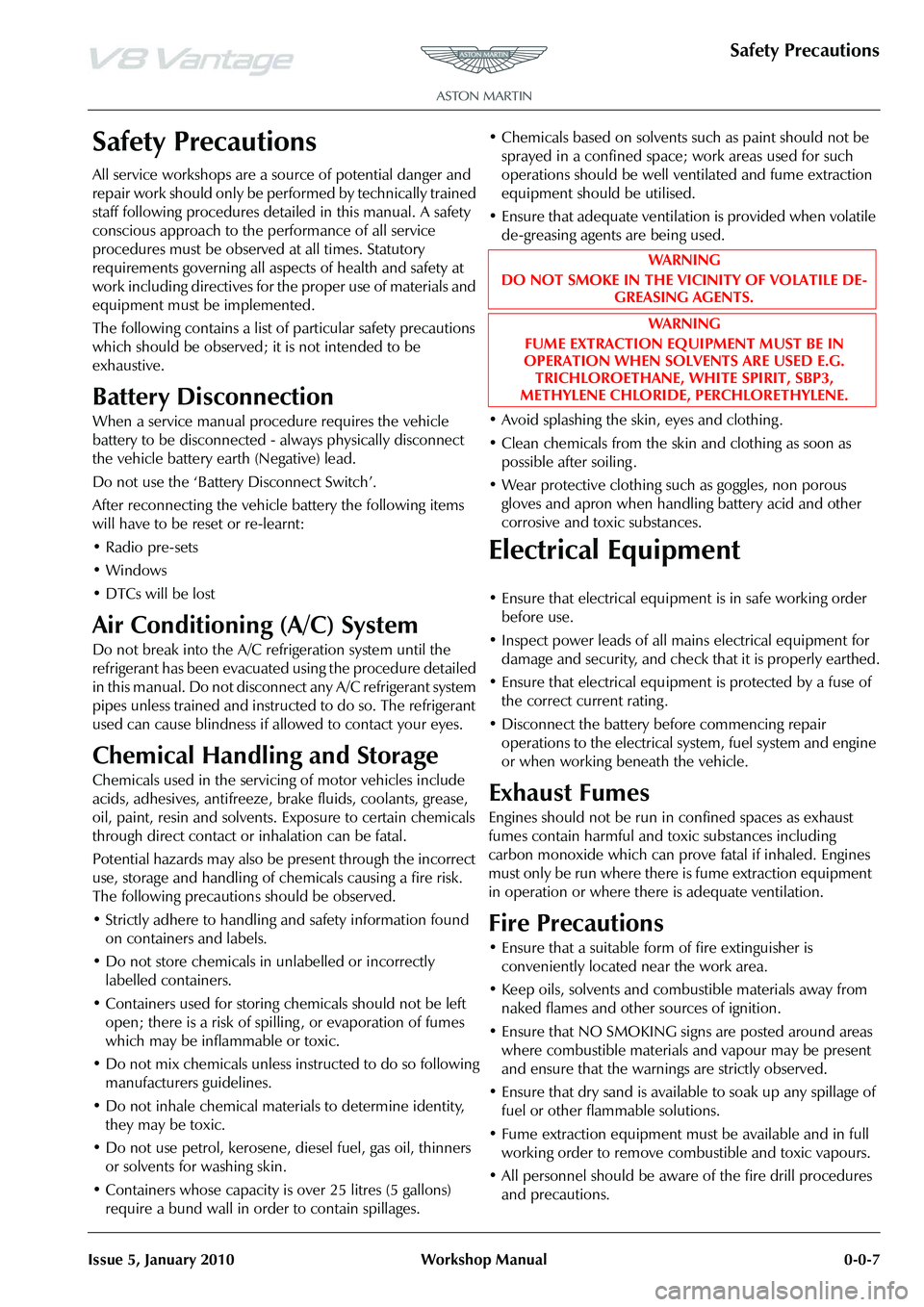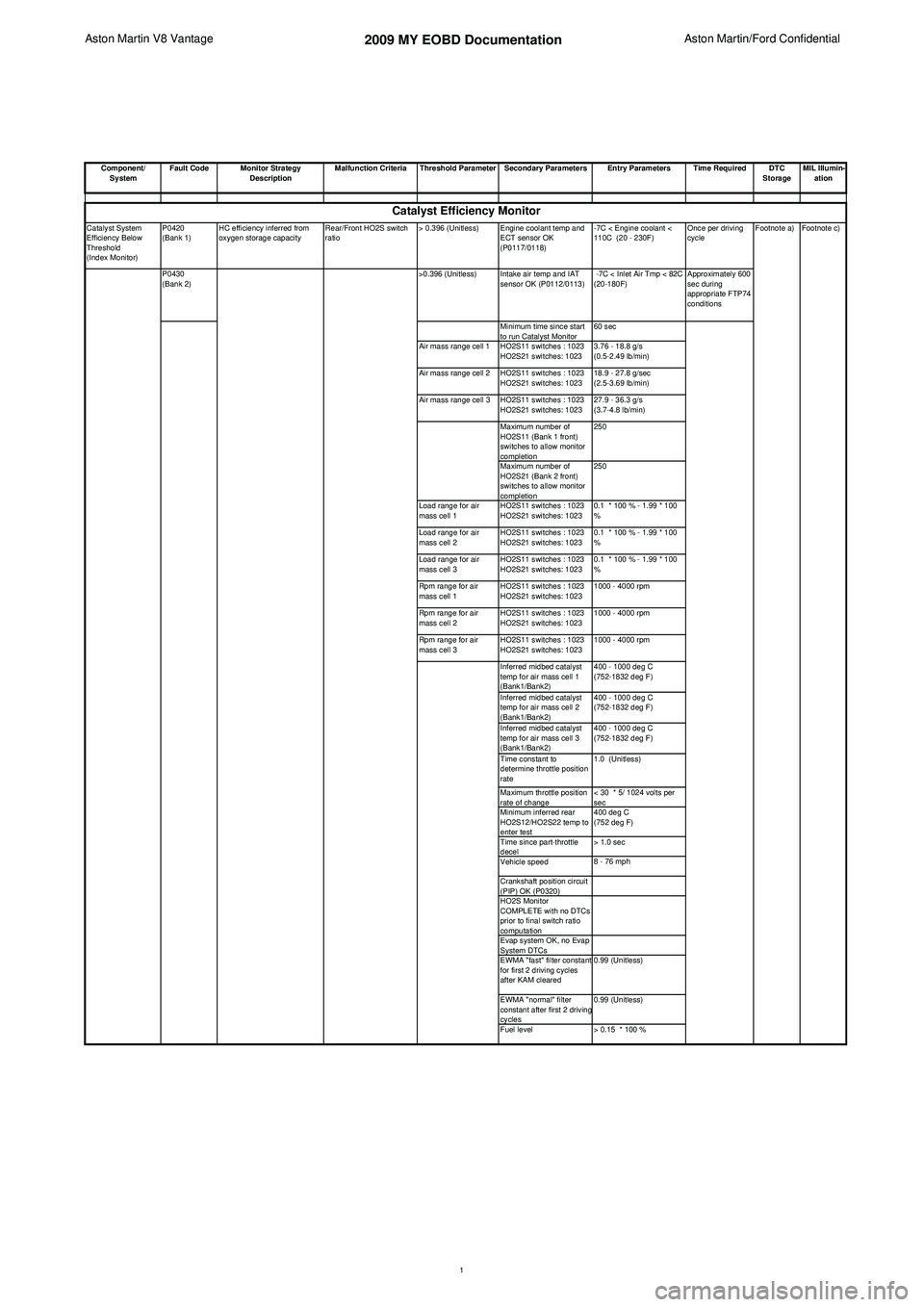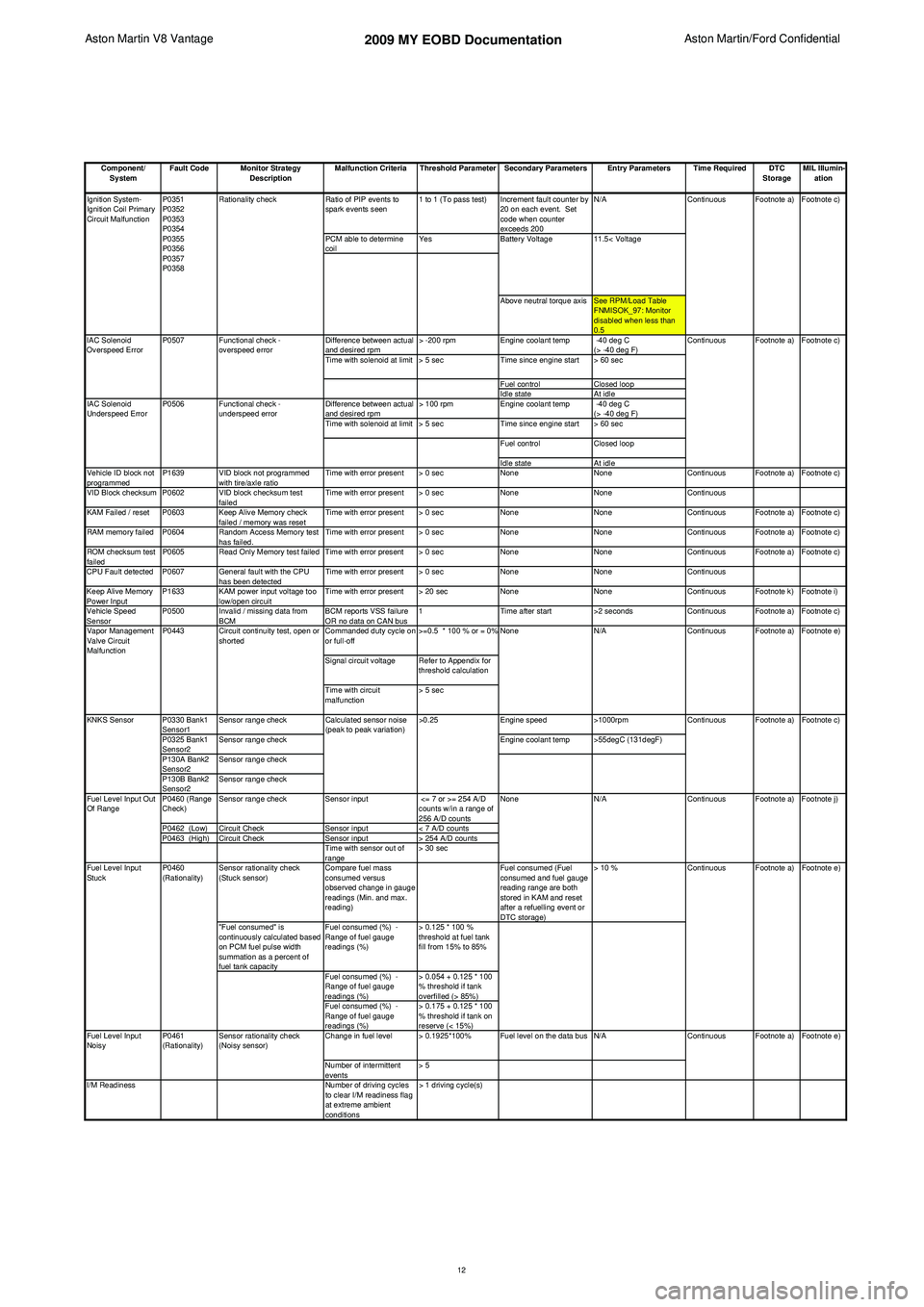coolant capacity ASTON MARTIN V8 VANTAGE 2010 Workshop Manual
[x] Cancel search | Manufacturer: ASTON MARTIN, Model Year: 2010, Model line: V8 VANTAGE, Model: ASTON MARTIN V8 VANTAGE 2010Pages: 947, PDF Size: 43.21 MB
Page 7 of 947

Safety Precautions
Issue 5, January 2010 Workshop Manual 0-0-7
Safety Precautions
All service workshops are a source of potential danger and
repair work should only be performed by technically trained
staff following procedures detailed in this manual. A safety
conscious approach to the performance of all service
procedures must be observed at all times. Statutory
requirements governing all aspects of health and safety at
work including directives for the proper use of materials and
equipment must be implemented.
The following contains a list of particular safety precautions
which should be observed; it is not intended to be
exhaustive.
Battery Disconnection
When a service manual procedure requires the vehicle
battery to be disconnected - always physically disconnect
the vehicle battery earth (Negative) lead.
Do not use the ‘Battery Disconnect Switch’.
After reconnecting the vehicle battery the following items
will have to be reset or re-learnt:
•Radio pre-sets
•Windows
• DTCs will be lost
Air Conditioning (A/C) System
Do not break into the A/C refrigeration system until the
refrigerant has been evacuated using the procedure detailed
in this manual. Do not disconne ct any A/C refrigerant system
pipes unless trained and instructed to do so. The refrigerant
used can cause blindness if allowed to contact your eyes.
Chemical Handling and Storage
Chemicals used in the servicing of motor vehicles include
acids, adhesives, antifreeze, brake fluids, coolants, grease,
oil, paint, resin and solvents. Exposure to certain chemicals
through direct contact or inhalation can be fatal.
Potential hazards may also be present through the incorrect
use, storage and handling of chemicals causing a fire risk.
The following precaution s should be observed.
• Strictly adhere to handling and safety information found on containers and labels.
• Do not store chemicals in unlabelled or incorrectly labelled containers.
• Containers used for storing chemicals should not be left open; there is a risk of spilling , or evaporation of fumes
which may be inflammable or toxic.
• Do not mix chemicals unless instructed to do so following manufacturers guidelines.
• Do not inhale chemical materials to determine identity, they may be toxic.
• Do not use petrol, kerosene, diesel fuel, gas oil, thinners or solvents for washing skin.
• Containers whose capacity is over 25 litres (5 gallons) require a bund wall in order to contain spillages. • Chemicals based on solvents such as paint should not be
sprayed in a confined space; work areas used for such
operations should be well ve ntilated and fume extraction
equipment should be utilised.
• Ensure that adequate ventilation is provided when volatile de-greasing agents are being used.
• Avoid splashing the skin, eyes and clothing .
• Clean chemicals from the skin and clothing as soon as
possible after soiling .
• Wear protective clothing such as goggles, non porous gloves and apron when handling battery acid and other
corrosive and toxic substances.
Electrical Equipment
• Ensure that electrical equipment is in safe working order before use.
• Inspect power leads of all mains electrical equipment for damage and security, and check that it is properly earthed.
• Ensure that electrical equipment is protected by a fuse of the correct current rating .
• Disconnect the battery before commencing repair operations to the electrical sy stem, fuel system and engine
or when working beneath the vehicle.
Exhaust Fumes
Engines should not be run in confined spaces as exhaust
fumes contain harmful and to xic substances including
carbon monoxide which can prove fatal if inhaled. Engines
must only be run where there is fume extraction equipment
in operation or where there is adequate ventilation.
Fire Precautions
• Ensure that a suitable form of fire extinguisher is conveniently located near the work area.
• Keep oils, solvents and combustible materials away from naked flames and other sources of ignition.
• Ensure that NO SMOKING signs are posted around areas where combustible materials and vapour may be present
and ensure that the warnings are strictly observed.
• Ensure that dry sand is availabl e to soak up any spillage of
fuel or other flammable solutions.
• Fume extraction equipment must be available and in full working order to remove combustible and toxic vapours.
• All personnel should be aware of the fire drill procedures and precautions. WAR NI NG
DO NOT SMOKE IN THE VICINITY OF VOLATILE DE- GREASING AGENTS.
WAR NI NG
FUME EXTRACTION EQUIPMENT MUST BE IN
OPERATION WHEN SOLVENTS ARE USED E.G. TRICHLOROETHANE, WHITE SPIRIT, SBP3,
METHYLENE CHLORIDE, PERCHLORETHYLENE.
Page 889 of 947

Aston Martin V8 Vantage 2009 MY EOBD DocumentationAston Martin/Ford Confidential
Component/ System Fault Code Monitor Strategy
Description Malfunction Criteria Threshold Parameter Secondary Parameters Entry Parameters Time Required DTC
StorageMIL Illumin-
ation
Catalyst System
Efficiency Below
Threshold
(Index Monitor) P0420
(Bank 1)
HC efficiency inferred from
oxygen storage capacity Rear/Front HO2S switch
ratio> 0.396 (Unitless) Engine coolant temp and
ECT sensor OK
(P0117/0118) -7C < Engine coolant <
110C (20 - 230F)
Once per driving
cycle
P0430
(Bank 2) >0.396 (Unitless) Intake air temp and IAT
sensor OK (P0112/0113) -7C < Inlet Air Tmp < 82C
(20-180F) Approximately 600
sec during
appropriate FTP74
conditions
Minimum time since start
to run Catalyst Monitor 60 sec
Air mass range cell 1 HO2S11 switches : 1023 HO2S21 switches: 1023 3.76 - 18.8 g/s
(0.5-2.49 lb/min)
Air mass range cell 2 HO2S11 switches : 1023 HO2S21 switches: 1023 18.9 - 27.8 g/sec
(2.5-3.69 lb/min)
Air mass range cell 3 HO2S11 switches : 1023 HO2S21 switches: 1023 27.9 - 36.3 g/s
(3.7-4.8 lb/min)
Maximum number of
HO2S11 (Bank 1 front)
switches to allow monitor
completion 250
Maximum number of
HO2S21 (Bank 2 front)
switches to allow monitor
completion 250
Load range for air
mass cell 1 HO2S11 switches : 1023
HO2S21 switches: 1023 0.1 * 100 % - 1.99 * 100
%
Load range for air
mass cell 2 HO2S11 switches : 1023
HO2S21 switches: 1023 0.1 * 100 % - 1.99 * 100
%
Load range for air
mass cell 3 HO2S11 switches : 1023
HO2S21 switches: 1023 0.1 * 100 % - 1.99 * 100
%
Rpm range for air
mass cell 1 HO2S11 switches : 1023
HO2S21 switches: 1023 1000 - 4000 rpm
Rpm range for air
mass cell 2 HO2S11 switches : 1023
HO2S21 switches: 1023 1000 - 4000 rpm
Rpm range for air
mass cell 3 HO2S11 switches : 1023
HO2S21 switches: 1023 1000 - 4000 rpm
Inferred midbed catalyst
temp for air mass cell 1
(Bank1/Bank2) 400 - 1000 deg C
(752-1832 deg F)
Inferred midbed catalyst
temp for air mass cell 2
(Bank1/Bank2) 400 - 1000 deg C
(752-1832 deg F)
Inferred midbed catalyst
temp for air mass cell 3
(Bank1/Bank2) 400 - 1000 deg C
(752-1832 deg F)
Time constant to
determine throttle position
rate 1.0 (Unitless)
Maximum throttle position
rate of change < 30 * 5/ 1024 volts per
sec
Minimum inferred rear
HO2S12/HO2S22 temp to
enter test 400 deg C
(752 deg F)
Time since part-throttle
decel > 1.0 sec
Vehicle speed 8 - 76 mph
Crankshaft position circuit
(PIP) OK (P0320)
HO2S Monitor
COMPLETE with no DTCs
prior to final switch ratio
computation
Evap system OK, no Evap
System DTCs
EWMA "fast" filter constant
for first 2 driving cycles
after KAM cleared 0.99 (Unitless)
EWMA "normal" filter
constant after first 2 driving
cycles 0.99 (Unitless)
Fuel level > 0.15 * 100 % Footnote a)
Footnote c)
Catalyst Efficiency Monitor
1
Page 900 of 947

Aston Martin V8 Vantage 2009 MY EOBD DocumentationAston Martin/Ford Confidential
Component/ System Fault Code Monitor Strategy
Description Malfunction Criteria Threshold Parameter Secondary Parameters Entry Parameters Time Required DTC
StorageMIL Illumin-
ation
Ratio of PIP events to
spark events seen 1 to 1 (To pass test) Increment fault counter by
20 on each event. Set
code when counter
exceeds 200 N/A
PCM able to determine
coil Yes
Above neutral torque axis See RPM/Load Table FNMISOK_97: Monitor
disabled when less than
0.5
Difference between actual
and desired rpm > -200 rpm
Engine coolant temp -40 deg C
(> -40 deg F)
Time with solenoid at limit > 5 sec Time since engine start > 60 sec
Fuel control Closed loop
Idle state At idle
Difference between actual
and desired rpm > 100 rpm
Engine coolant temp -40 deg C
(> -40 deg F)
Time with solenoid at limit > 5 sec Time since engine start > 60 sec
Fuel control Closed loop
Idle state At idle
Vehicle ID block not
programmed P1639 VID block not programmed
with tire/axle ratio Time with error present > 0 sec
NoneNoneContinuous Footnote a) Footnote c)
VID Block checksum P0602 VID block checksum test failedTime with error present > 0 sec
NoneNoneContinuous
KAM Failed / reset P0603 Keep Alive Memory check failed / memory was resetTime with error present > 0 sec
NoneNoneContinuous Footnote a) Footnote c)
RAM memory failed P0604 Random Access Memory test has failed.Time with error present > 0 sec
NoneNoneContinuous Footnote a) Footnote c)
ROM checksum test
failed P0605 Read Only Memory test failed Time with error present > 0 sec
NoneNoneContinuous Footnote a) Footnote c)
CPU Fault detected P0607 General fault with the CPU has been detectedTime with error present > 0 sec
NoneNoneContinuous
Keep Alive Memory
Power Input P1633 KAM power input voltage too
low/open circuit Time with error present > 20 sec
NoneNoneContinuous Footnote k) Footnote i)
Vehicle Speed
Sensor P0500 Invalid / missing data from
BCM BCM reports VSS failure
OR no data on CAN bus1
Time after start >2 secondsContinuous Footnote a) Footnote c)
Commanded duty cycle on
or full-off >=0.5 * 100 % or = 0%
Signal circuit voltage Refer to Appendix for threshold calculation
Time with circuit
malfunction > 5 sec
P0330 Bank1
Sensor1 Sensor range check
Engine speed>1000rpm
P0325 Bank1
Sensor2 Sensor range check
Engine coolant temp >55degC (131degF)
P130A Bank2
Sensor2 Sensor range check
P130B Bank2
Sensor2 Sensor range check
P0460 (Range
Check) Sensor range check
Sensor input <= 7 or >= 254 A/D
counts w/in a range of
256 A/D counts
P0462 (Low) Circuit Check Sensor input< 7 A/D counts
P0463 (High) Circuit Check Sensor input> 254 A/D counts
Time with sensor out of
range > 30 sec
Sensor rationality check
(Stuck sensor) Compare fuel mass
consumed versus
observed change in gauge
readings (Min. and max.
reading) Fuel consumed (Fuel
consumed and fuel gauge
reading range are both
stored in KAM and reset
after a refuelling event or
DTC storage)> 10 %
"Fuel consumed" is
continuously calculated based
on PCM fuel pulse width
summation as a percent of
fuel tank capacity Fuel consumed (%) -
Range of fuel gauge
readings (%)
> 0.125 * 100 %
threshold at fuel tank
fill from 15% to 85%
Fuel consumed (%) -
Range of fuel gauge
readings (%) > 0.054 + 0.125 * 100
% threshold if tank
overfilled (> 85%)
Fuel consumed (%) -
Range of fuel gauge
readings (%) > 0.175 + 0.125 * 100
% threshold if tank on
reserve (< 15%)
Change in fuel level > 0.1925*100% Fuel level on the data bus N/A
Number of intermittent
events > 5
I/M Readiness Number of driving cycles
to clear I/M readiness flag
at extreme ambient
conditions > 1 driving cycle(s) Footnote e)
Footnote a)
Footnote c)
Footnote a) Footnote j) Footnote e)
Fuel Level Input
Noisy Continuous Footnote a)
Continuous Footnote a)
P0461
(Rationality) Sensor rationality check
(Noisy sensor)
Fuel Level Input
Stuck
P0460
(Rationality) Continuous
N/A Continuous
Calculated sensor noise
(peak to peak variation)
>0.25
KNKS Sensor
Fuel Level Input Out
Of Range NoneFootnote a) Footnote e)
Vapor Management
Valve Circuit
Malfunction P0443 Circuit continuity test, open or
shorted None
N/A Continuous
11.5< Voltage
Ignition System-
Ignition Coil Primary
Circuit Malfunction
IAC Solenoid
Underspeed Error P0507
P0506
Functional check -
overspeed error
Functional check -
underspeed error
IAC Solenoid
Overspeed Error
Footnote a) Footnote c)
Continuous
P0351
P0352
P0353
P0354
P0355
P0356
P0357
P0358
Rationality check
Continuous Footnote a) Footnote c)
Battery Voltage
12
Page 912 of 947

Aston Martin V12 Family
2009 MY V12 Family EOBDincl. V12 Vantage
Aston Martin/Ford Confidential
Component/ System Fault Code Monitor Strategy
Description Malfunction Criteria Threshold Parameter Secondary Parameters Entry Parameters Time Required DTC
StorageMIL Illumin-
ation
P0420
(Bank 1) HC efficiency inferred from
oxygen storage capacity Rear/Front HO2S switch
ratio> 0.76 (Unitless) Engine coolant temp and
ECT sensor OK
(P0117/0118) 65C < Engine coolant
< 110C (150 - 230F)
Once per driving
cycleFootnote a) Footnote c)
P0430
(Bank 2) HC efficiency inferred from
oxygen storage capacity Rear/Front HO2S switch
ratio>0.76 (Unitless) Intake air temp and IAT
sensor OK (P0112/0113) -7C < Inlet Air Tmp
< 82C (20-180F) Approximately 900
sec
Minimum time since start
to run Catalyst Monitor 60 sec
Air mass range cell 1 HO2S11 switches : 200 HO2S21 switches: 200 3.78 - 11.3 g/s
(0.5-1.5 lb/min)
Air mass range cell 2 HO2S11 switches : 200 HO2S21 switches: 200 11.3 - 18.9 g/sec
(1.5-2.5 lb/min)
Air mass range cell 3 HO2S11 switches : 200 HO2S21 switches:
FEGO2_MX_CT3 18.9 - 26.5 g/s
(2.5-3.5 lb/min)
Maximum number of
HO2S11 (Bank 1 front)
switches to allow monitor
completion 300
Maximum number of
HO2S21 (Bank 2 front)
switches to allow monitor
completion 300
Load range for air
mass cell 1 HO2S11 switches : 200
HO2S21 switches: 200 0.1 * 100 % - 1.0 * 100 %
Load range for air
mass cell 2 HO2S11 switches : 200
HO2S21 switches: 200 0.1 * 100 % - 1.0 * 100 %
Load range for air
mass cell 3 HO2S11 switches : 200
HO2S21 switches: 200 0.1 * 100 % - 1.0 * 100 %
Rpm range for air
mass cell 1 HO2S11 switches : 200
HO2S21 switches: 200 0 - 4000 rpmCatalyst Efficiency MonitorCatalyst System
Efficiency Below
Threshold
(Index Monitor)
1